I've been trading cryptocurrencies for ten years and made 30 million, but the biggest secret is: most of the time, I'm not 'trading'. In this market that advocates 'working hard to get rich', 90% of people are heading towards poverty due to overexertion.
Today, I want to tell you how to conquer the market with 'laziness' in the crazy cryptocurrency world.
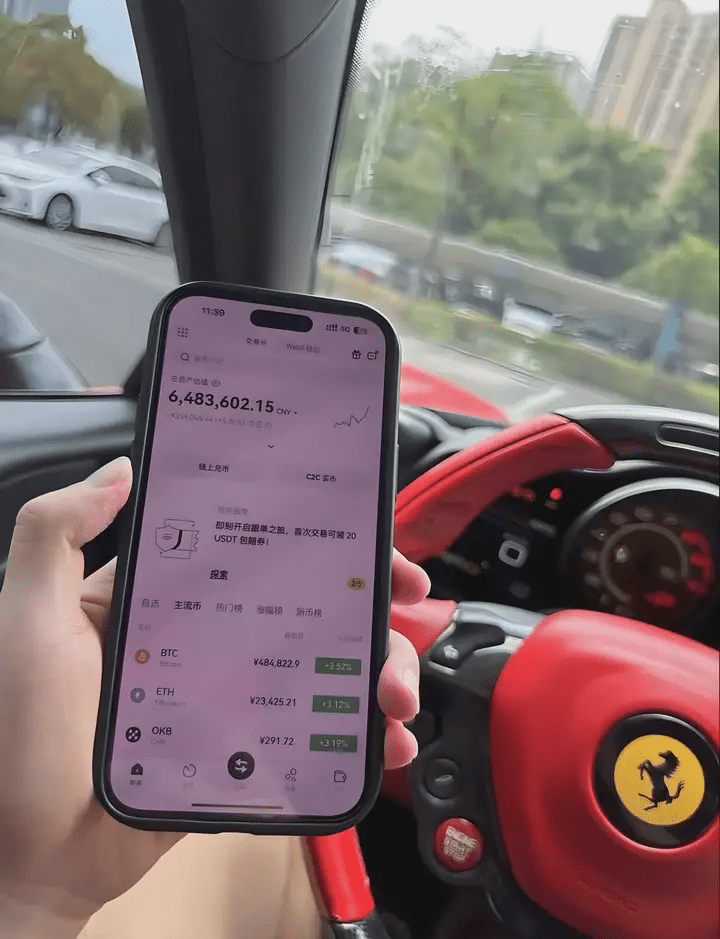 If you expect to get rich immediately after reading this article, you can turn it off now. I don't have the 'wealth code' here, only a set of 'survival rules' that helped me survive three bull and bear markets and accumulate thirty million in assets. This is not a feel-good article, but a 'check-up report' that will diagnose the most fatal issues in your investment system.
If you expect to get rich immediately after reading this article, you can turn it off now. I don't have the 'wealth code' here, only a set of 'survival rules' that helped me survive three bull and bear markets and accumulate thirty million in assets. This is not a feel-good article, but a 'check-up report' that will diagnose the most fatal issues in your investment system.
The concept of smart money is the core logic that can help you establish a huge profit advantage in trading—it allows you to see through the essence of price movements and accurately find high risk-reward entry points, instead of being swayed by superficial fluctuations. Today, I will thoroughly explain the core logic, practical methods, and trading setups of smart money, from basic concepts to actionable strategies—all practical content you can use.
Basic concepts of smart money.
Four core principles, first solidify the underlying logic.
To effectively use smart money, first master four basic concepts, which are prerequisites for analyzing charts and determining direction.
Core 1: Accurately identify trend direction (dominance of bulls vs bears).
The first step in analyzing charts is always to determine the trend direction—understanding whether the bulls or bears are dominant allows you to trade in the direction of the higher probability. Remember: always look for entry points in the direction of the dominant side; trading against the trend will significantly lower your win rate.
Share a simple and memorable judgment mantra:
If the demand zone is broken, it indicates that supply is dominant (bearish strength);
If the supply zone is broken, it indicates that demand is dominant (bullish strength).
Seeing two practical examples is more intuitive:
Weakening of an upward trend: the price was originally in an 'highs high, lows high' upward structure, with a demand zone below. However, after reaching the demand zone, there was no bullish signal, and instead, it broke the demand zone and previous low, forming a 'lows lower' downward structure. This conveys two signals: first, supply has replaced demand as the dominant force; second, the broken demand zone will transform into a new supply zone, allowing for shorting when the price approaches.
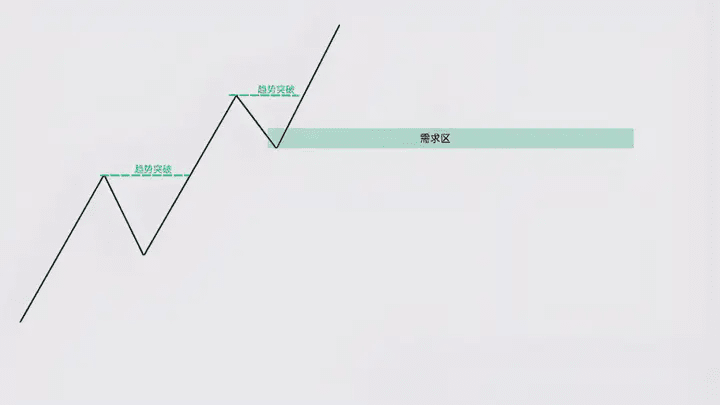
 Reversal of a downward trend: the price was originally in a 'highs lower, lows lower' downward structure, with a supply zone above. However, after reaching the supply zone, there was no bearish signal, and instead, it broke the supply zone and previous high, forming a 'highs high' upward structure. This also conveys two signals: first, demand has surpassed supply to become dominant; second, the broken supply zone will transform into a new demand zone, allowing for long entries when the price retraces.
Reversal of a downward trend: the price was originally in a 'highs lower, lows lower' downward structure, with a supply zone above. However, after reaching the supply zone, there was no bearish signal, and instead, it broke the supply zone and previous high, forming a 'highs high' upward structure. This also conveys two signals: first, demand has surpassed supply to become dominant; second, the broken supply zone will transform into a new demand zone, allowing for long entries when the price retraces.
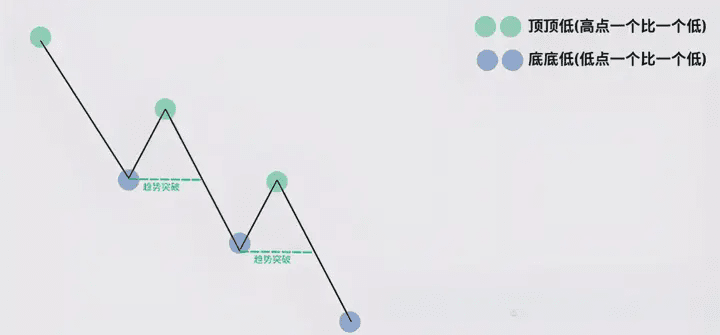
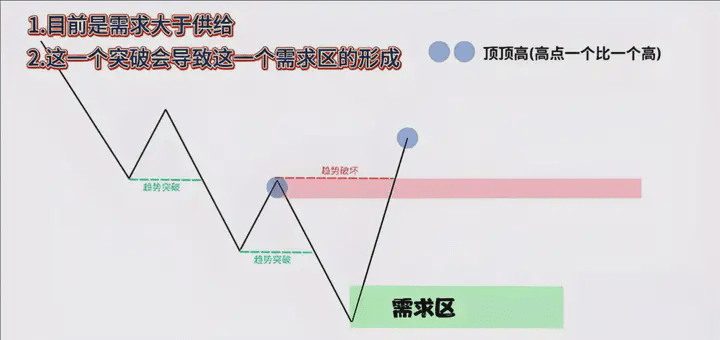
Core 2: Understand market structure (the 'skeleton' of trends).
The market structure dominated by smart money centers on 'continuation and destruction of trends', with different trends having clear structural characteristics: upward trend structure: prices continuously form 'highs high, lows high'; each rise after a retracement will break the previous high and raise the previous low. At this point, look for 'demand zones forming trend breakouts' (preferably including imbalance zones or liquidity); these demand zones have the highest win rate and are key long entry points.
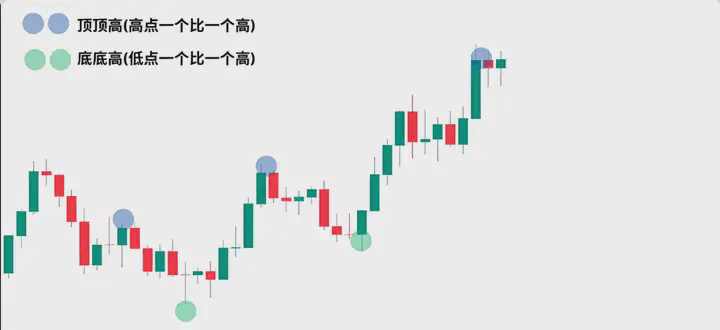
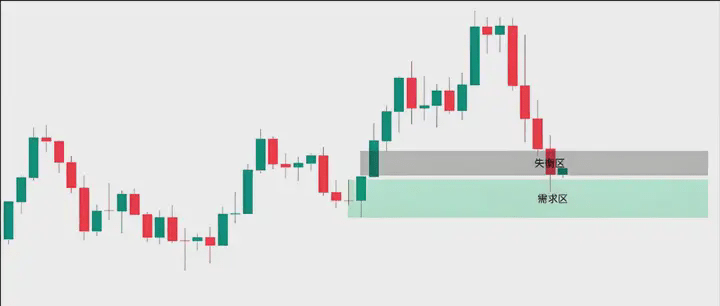 Downward trend structure: prices continuously form 'highs lower, lows lower'; each drop after a rebound will break the previous low and lower the previous high. At this point, look for the 'supply zone forming a trend breakout' (preferably including an imbalance zone or liquidity), as these supply zones have the highest win rate and are key shorting price levels.
Downward trend structure: prices continuously form 'highs lower, lows lower'; each drop after a rebound will break the previous low and lower the previous high. At this point, look for the 'supply zone forming a trend breakout' (preferably including an imbalance zone or liquidity), as these supply zones have the highest win rate and are key shorting price levels.
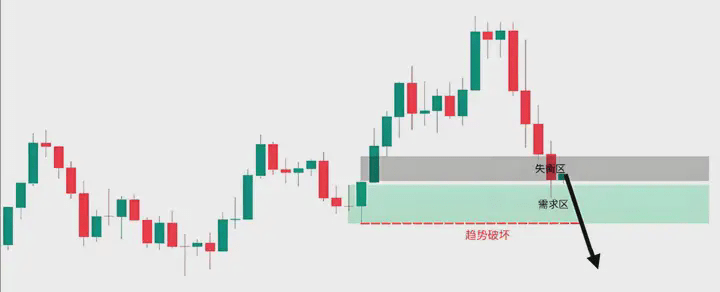 Key reminder: when the original structure is broken, the trend is likely to reverse—during an upward trend, if the price breaks the low point of 'lows high' and the demand zone, forming 'lows lower', it indicates the end of the uptrend and the start of a downtrend.
Key reminder: when the original structure is broken, the trend is likely to reverse—during an upward trend, if the price breaks the low point of 'lows high' and the demand zone, forming 'lows lower', it indicates the end of the uptrend and the start of a downtrend.
In a downward trend, the price breaks the high point of the 'highs lower' and the supply zone, forming 'highs high', indicating the end of the downtrend and the start of an uptrend.
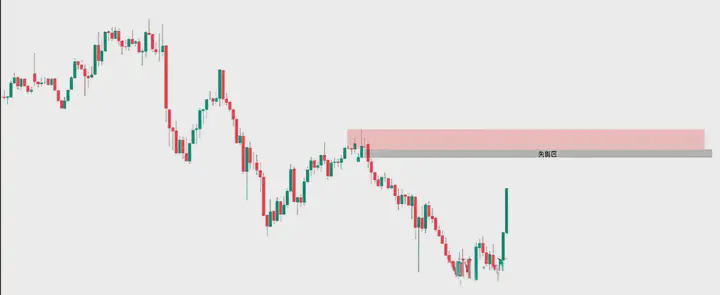 Core 3: Find high win-rate supply and demand zones (smart money's 'cost zone').
Core 3: Find high win-rate supply and demand zones (smart money's 'cost zone').
Supply and demand zones are the price levels where smart money concentrates its entry, and they are also key areas where prices are likely to react subsequently. The core characteristics of high win-rate supply and demand zones:
In an upward trend, focus on the demand zones that form trend breakouts and include imbalance zones;
In a downward trend, focus on the supply zones that form trend breakouts and include imbalance zones;
There must be liquidity near the supply and demand zone (such as a large number of stop-loss orders) for the price to be more easily attracted there.
Core 4: Identify liquidity (smart money's 'target levels').
Liquidity refers to concentrated stop-loss orders in the market; smart money often grabs this liquidity first before pushing the price in the target direction. For example:
Support/resistance levels that have been tested multiple times: many traders will place orders at these price levels, gathering a large number of stop-loss orders below/above, typical of liquidity zones;
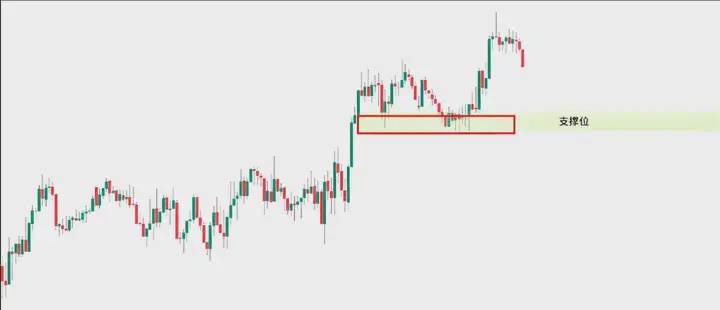 Previous highs and lows: especially key highs and lows in the trend structure often have a large number of stop-loss orders, and smart money will trigger these stops before initiating the trend.
Previous highs and lows: especially key highs and lows in the trend structure often have a large number of stop-loss orders, and smart money will trigger these stops before initiating the trend.
Advanced concept: market structure + liquidity.
Key to improving win rates
Simply observing structure or liquidity isn't enough; combining both is essential to find high-certainty opportunities; remember two key points:
1. The 'liquidity grab' logic of smart money.
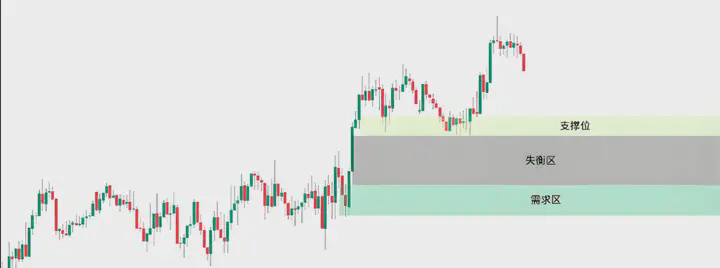 In an upward trend, when there is a support level (liquidity zone) that has been tested multiple times, and there are imbalance zones and demand zones below, the price is likely to first drop to grab liquidity below the support level (triggering stop-losses) and then quickly rebound. At this point, going long in the demand zone below is a high-quality entry.
In an upward trend, when there is a support level (liquidity zone) that has been tested multiple times, and there are imbalance zones and demand zones below, the price is likely to first drop to grab liquidity below the support level (triggering stop-losses) and then quickly rebound. At this point, going long in the demand zone below is a high-quality entry.
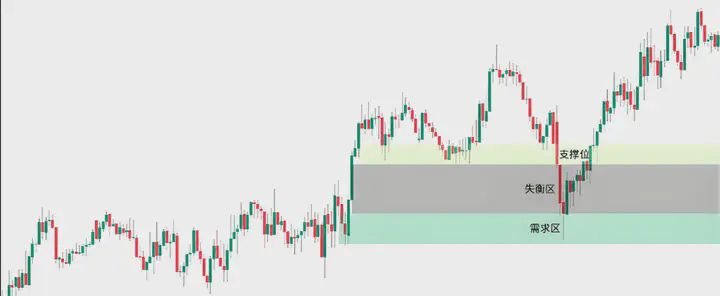 Core principle: smart money does not directly push up/down but first clears retail stop-losses (grabbing liquidity) before operating in its own direction. Therefore, we should wait for liquidity to be grabbed before entering a trade, rather than entering early at support/resistance levels.
Core principle: smart money does not directly push up/down but first clears retail stop-losses (grabbing liquidity) before operating in its own direction. Therefore, we should wait for liquidity to be grabbed before entering a trade, rather than entering early at support/resistance levels.
2. Tips for anticipating liquidity zones.
Before entering any trade, always 'look right' to check for potential liquidity or risks:
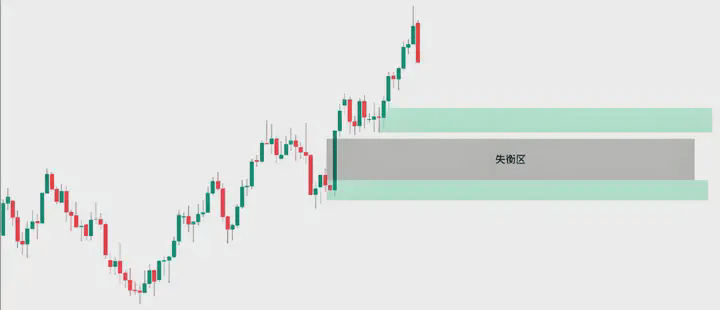 If there is another imbalance zone or demand zone below a demand zone, then the demand zone above is likely a liquidity zone. The price will first break it to grab stop losses, then trigger the imbalance zone and demand zone below before rising.
If there is another imbalance zone or demand zone below a demand zone, then the demand zone above is likely a liquidity zone. The price will first break it to grab stop losses, then trigger the imbalance zone and demand zone below before rising.
 Anticipating these hidden dangers can help you avoid low win-rate traps and improve trading quality.
Anticipating these hidden dangers can help you avoid low win-rate traps and improve trading quality.
Three smart money trading setups.
High win rates can be implemented immediately.
After mastering the fundamentals and advanced concepts, let's look at three of the most effective trading setups in practice, each with clear entry logic and rules.
Trading setup 1: Simple order quick entry (catch trend initiation point).
Order blocks are the 'last K-line that forms a trend breakout and includes an imbalance zone'; satisfying the following three points constitutes a high-quality order block, allowing for direct entry:
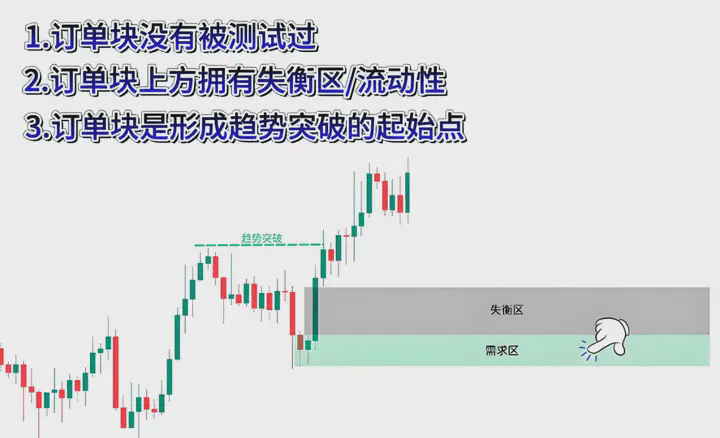
Order blocks that have not been tested (first retracement to that price level);
Imbalance zones above/below;
is the starting point of trend breakout (for example, the last bullish candle that breaks the previous high in an upward trend).
Three keys to improving win rates:
Must enter along with the large trend, aligning with trend momentum for a higher win rate;
Check key price levels on a large scale: observe the distance between small-level order blocks and large-level key levels to ensure it is sufficient for taking profit (large-level retracements may lead to small-level trend destruction);
Look to the right at the price structure: confirm there are no potential liquidity zones or risk points to avoid being stopped out after entering.
 Trading setup 2: grab liquidity model (catch trend continuation points).
Trading setup 2: grab liquidity model (catch trend continuation points).
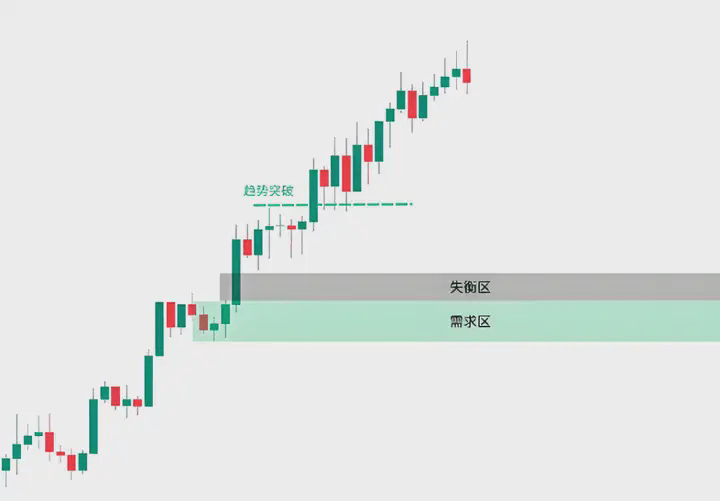 In an upward trend, if the price breaks without forming a new imbalance zone, but there are imbalance zones and order blocks below, the previous low (the support level of the trend structure) is likely a liquidity zone—many traders will go long at this low, gathering a lot of stop losses below.
In an upward trend, if the price breaks without forming a new imbalance zone, but there are imbalance zones and order blocks below, the previous low (the support level of the trend structure) is likely a liquidity zone—many traders will go long at this low, gathering a lot of stop losses below.
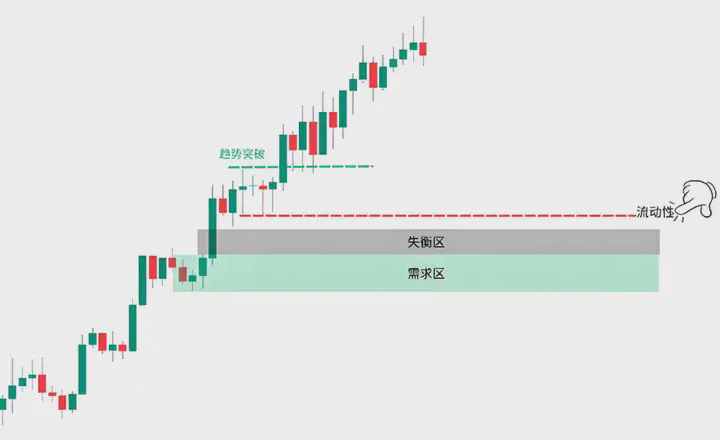 Entry logic: wait for the price to drop to grab liquidity below that low (triggering stop-losses), then trigger the imbalance zone and order blocks below, at which point enter long; the risk-reward ratio is extremely high.
Entry logic: wait for the price to drop to grab liquidity below that low (triggering stop-losses), then trigger the imbalance zone and order blocks below, at which point enter long; the risk-reward ratio is extremely high.
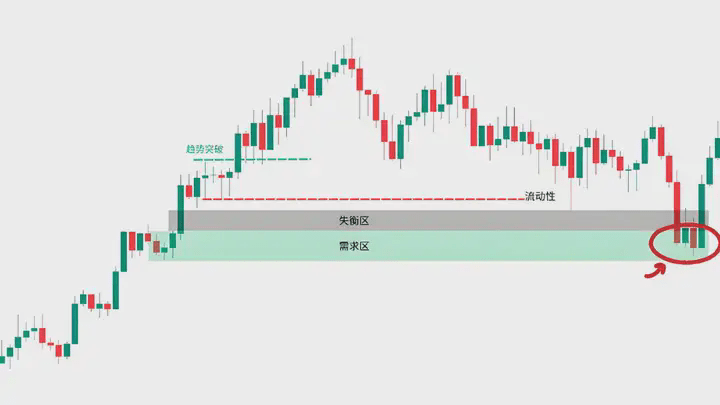 Trading setup 3: Dual order block resonance (multi-level confirmation, high certainty).
Trading setup 3: Dual order block resonance (multi-level confirmation, high certainty).
Utilize the resonance of order blocks at both large and small time frames to further improve win rates, with the following steps:
When the price reaches a large-level order block (such as a 4-hour demand zone order block);
Switch to a smaller scale (like 1 hour or 15 minutes), observe if a trend destruction occurs (like a downward trend turning into an upward 'highs high' structure);
Find order blocks that form trend breakouts and include imbalance zones at a small scale;
When the price reaches a small-level order block, enter long/short.
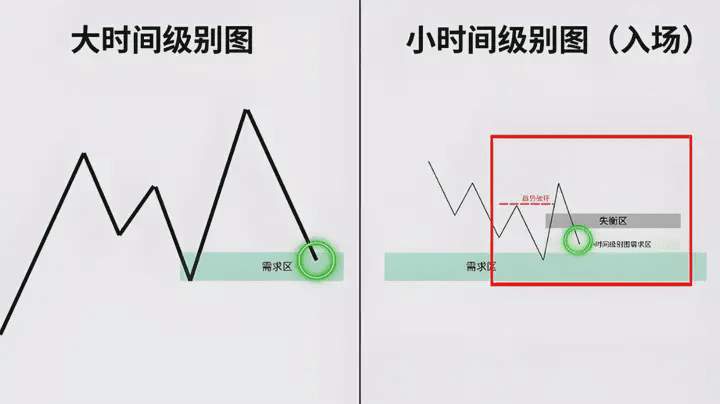 Core logic: large-level order blocks provide 'big direction support/resistance', while small-level order blocks offer 'precise entry points'; both resonate, and the certainty far exceeds single-level signals.
Core logic: large-level order blocks provide 'big direction support/resistance', while small-level order blocks offer 'precise entry points'; both resonate, and the certainty far exceeds single-level signals.
Final summary.
Core principles of smart money trading.
Trend following is king: always trade in the direction of trend structure and the dominance of bulls vs bears; firmly avoid counter-trend trades.
Multi-dimensional confirmation: a single signal is unreliable; combining trend structure, supply and demand zones, liquidity, and multi-level resonance improves win rates.
Be patient: smart money will first grab liquidity; don't rush to enter; wait for key signals to confirm before acting.
Risk pre-positioning: before entering, always look right to anticipate potential liquidity and large-level key price levels, and prepare risk management in advance.
The essence of smart money trading is to see through the market's 'capital flow' and 'retail behavior', thinking from the perspective of the main force—following the footsteps of smart capital, avoiding retail stop-loss traps, and continuously seizing high risk-reward trading opportunities. Mastering these logics and setups will significantly enhance your trading win rate and risk-reward ratio.
I am Xiao Yue, a professional analyst and educator, a mentor and friend on your investment journey! As an analyst, the most basic thing is to help everyone make money. I will solve your confusion and issues, speaking with strength. When you lose your way and don't know what to do, follow Xiao Yue; I will guide you in the right direction #ETH走势分析 $ETH
